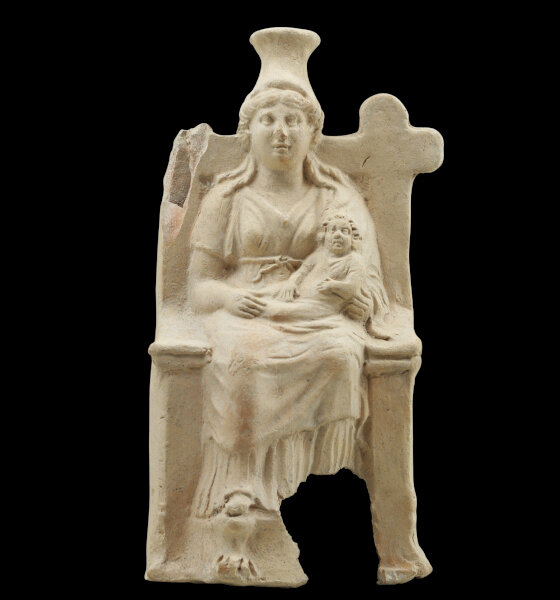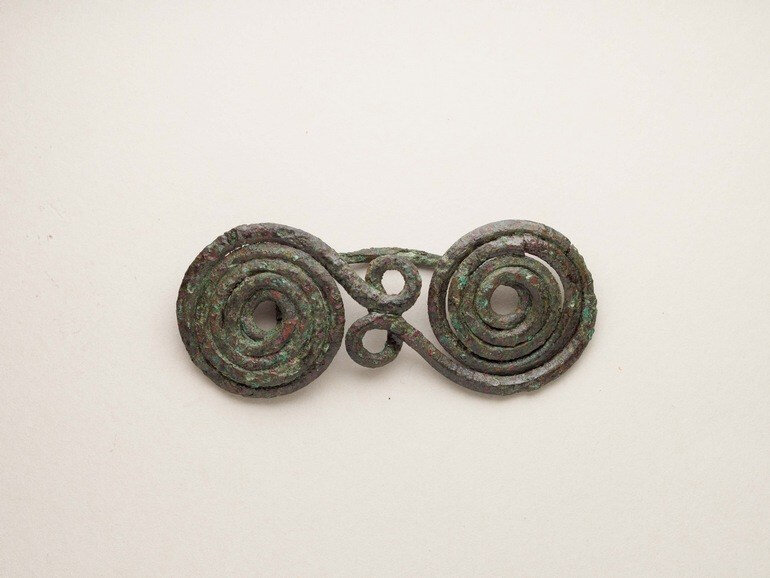Three ancient cities revived: Museum of Cycladic Art opens new archaeological exhibition
ATHENS.- The Museum of Cycladic Art and the Regional Services of the Hellenic Ministry of Culture and Sports (Ephorates of Antiquities of Chania, Rethymno, and Herakleion) are co-organizing the exhibition entitled “Crete. Emerging cities: Aptera ― Eleutherna ― Knossos. Three ancient cities revived” from 12 December 2018 to 30 April 2019. This is a multi-faceted exhibition with rich audio-visual aids, including screens, maps, and innovative technologies.
The exhibition focuses on three of Crete’s one-hundred cities, according to Homer (hekatompolis), and their common characteristics: their establishment, acme, decline, destruction, abandonment, and demise. Cities with centuries-long history, cities that were abandoned and forgotten, but are also tangible examples of archaeological investigation using similar or different approaches.
The exhibition comprises approximately 500 artefacts dating from the Neolithic (7th-6th millennium BC) to the Byzantine period (8th century AD), some newly discovered, others from old excavations, most of them never presented to the public before: statues, reliefs, figurines, inscriptions, vases, weapons, jewellery, coins, and other artefacts of various materials—limestone, marble, clay, metal (bronze, iron, silver, and gold), faience, glass, ivory, and semi-precious stones. This is the first time that so many artefacts leave the storerooms of the Antiquities Ephorates and display cases of the museums of Crete for a temporary exhibition in Athens.
In lieu of a prologue to the exhibition, Professor Nikos Chr. Stampolidis, Director of the Museum of Cycladic Art, writes:
ANCIENT CITIES
You said: “I’ll go to another country, go to another shore, find another city better than this one… the black ruins of my life… where I’ve spent so many years…”
You will always end up in this city… in this small corner…*
Lines extracted from K. P. Cavafy’s poem The city Fragments taken deliberately but not at random.
It is another, different reading for those who dig, for archaeologists, those who seek, see, read, and touch like Seferis’s King of Asine the stones. Random and fragmentary, the centuries-old ruins and finds from these apiaries of human life and creation, the cities; ancient cities like those emerging from the pages of time and the layers of dust on their ravaged remains.
“Dust and Oblivion”.
Oblivion, lethe, the thieves of memory. As memory awaits emergence the fruit of the devotion of those who love and respect the past, the great teacher of the present and future; the fruit of the devotion of those who look back, and ponder, and work in “small corners” And the cities that emerge through their hands a part of their own journey “to another country, … to another shore” a journey across the oceans of time penetrating its oblique veils, cracks of light in the dark; a journey that evades the “small corner” and reaches the “city that always pursues you” the city inside you.
N. Chr. Stampolidis (*Translated by Edmund Keeley/Philip Sherrard)
Terracotta bust of bearded male figure, possibly Zeus, 31 BC – 324 AD. Photo: George Anastasakis © Museum of Cycladic Art.
Antiquities from each one of the three cities speak of its territory, public and private life, religious beliefs, sanctuaries, and cemeteries, fragments of its historical continuum. A special place is given to artefacts relating to each city’s founding myths and also to personal stories: Soterios from Eleutherna who live and died at Aptera, the young man of Eleutherna who died before knowing love, and the child buried with their toys at Knossos.
The exhibition also showcases Renaissance books and maps, including the Vincenzo Maria Coronelli’s map of Crete (1707) with its famous fruit garland inscribed with the names of the 100 Cretan cities mentioned by Homer, including the three presented here.
A map of Crete that covers the exhibition hall’s floor gives visitors the impression of walking over the island itself. This novel way of depicting the three revived cities using Google Earth was realized by Αris Zambikos – GR405 architects. Videos featuring aerial views of the sites and images of earlier and recent excavations, drawings, restorations, and conservation and promotion work complete the exhibition. Orthi Petra (Necropolis), an original musical composition by Yiorgos Kaloudis for four-stringed Cretan lyra with sympathetic strings and cello, accompanies the display of the artefacts from the homonymous cemetery of Eleutherna.
The exhibition concludes with a surprise: two bull’s heads hovering over the sea that surrounds Crete, one Minoan, the other by Picasso—a prelude to the Museum’s upcoming exhibition entitled Picasso and Antiquity. Line and clay. Scheduled to open in June 2019, this exhibition will showcase Cretan, Greek, and Mediterranean antiquities, as part of the Museum of Cycladic Art’s Divine Dialogues series.
The present exhibition is organised in collaboration with the Archaeological Museum of Herakleion, the Archaeological Museum of Rethymno, the University of Crete – Museum of Ancient Eleutherna Research Centre, the British School at Athens – Knossos Stratigraphic Museum, and FABA – Fundación Almine y Bernard Ruiz-Picasso para el Arte (lender of Picasso’s bull’s head), with the participation of the American School of Classical Studies at Athens – Gennadius Library, the Sylvia Ioannou Foundation, and the Benaki Museum, who contributed Renaissance maps and books. The exhibition is realized with the support of the Region of Crete.
The exhibition catalogue is published in Greek and English.
On the occasion of the exhibition, the Museum’s Department of Educational Programmes has designed educational programmes and guided tours to introduce children aged 8 years and over to various aspects of public and private life in ancient Crete.

“Crete. Emerging cities: Aptera ― Eleutherna ― Knossos. Three ancient cities revived”, 12 December 2018 – 30 April 2019. Installation view.
KNOSSOS
The earliest of the three, Knossos, has a long history of exploration, well known and well recorded since Minos Kalokairinos and Arthur Evans to the present day. With its reconstructed palace and millions of visitors, Knossos is now the second most popular archaeological site in Greece after the Athenian Acropolis. The present exhibition, however, focuses not on the famous palace but on the city that lay beyond it both spatially and temporally. It showcases the copious and continuous efforts of archaeologists in the Archaeological Service and the British School at Athens, and of all those who contribute in one way or another to provide as full a picture as possible of this great Cretan city. The present exhibition demonstrates that Knossos was not just a palace but an entire city that stretched beyond it, a city whose history began long before the palace was built, in the Neolithic period, and lasted long after it was destroyed; a city with a vast territory, served by its harbours and cemeteries not only during the Old and New Palace periods but also later, in the Geometric, Archaic, Classical, Hellenistic, and Roman periods, a city that was Christianised in the Early Byzantine period, as its Early Christian basilicas and other finds testify.
Terracotta figurine of Isis enthroned with child. 31 BC – AD 324, Knossos. © MCS/Ephorate of Antiquities of Herakleion.
Marble head of male figure, probably Zeus, Knossos, 31 BC - 324 AD.
Bronze eight-buckle. Knossos, late 8th c. B.C.
ELEUTHERNA
Eleutherna is a different story. Here, systematic excavation began recently, and the site’s conservation, restoration, and promotion were approached differently thanks to the lessons learned at Knossos. Eleutherna was all but forgotten after the ancient and medieval city’s forced abandonment. It was either incorrectly marked (usually east or south of its actual location), or confused with Apollonia to the northwest of Herakleion, or omitted altogether on many Cretan maps of the 15th to 17th centuries. There are occasional references to the site during this period, either by travellers who visited it, who reported from hearsay, or who compiled information provided by others. This was remedied in the 18th and, especially, 19th centuries, when the site’s correct location was given on maps and references to the site became more specific. Rivalries between foreign archaeological schools (particularly the British and Italian Schools) over who would excavate Eleutherna delayed the site’s exploration. It wasn’t until the Cretan State developed an interest in promoting Crete’s Greek identity that Eleftherios Venizelos asked educator Efstathios Petroulakis to restore the Hellenistic bridge, which a flood had destroyed in 1898, as part of a programme to modernise the island’s road network in 1908. In the same year, Petroulakis became the first to investigate part of the acropolis there. Humfry Payne conducted a short-lived archaeological excavation in 1929, but systematic investigations did not begin until the University of Crete surveyed the site in 1984 and initiated the on-going excavations the following year.
Gold pendant. Before the mid-7th c. BC, Eleutherna. © University of Crete/Research Center, Museum of ancient Eleftherna.
Amphora, 700-675 BC, Eleutherna. Photo: Giorgos Anastasakis © Museum of Cycladic Art.
A bronze lamp in the form of a female panther, on which is depicted Dionysus, Eleutherna, 2nd / 1st c. B.C. - 1st / 2nd cent. A.D.
APTERA
Aptera, a city that commands Souda Bay and the far reaches of the Apokoronas plain, was investigated in a similar manner to Eleutherna, although 15th-century maps gave a more accurate location. Robert Pashley identified the city in 1834, and the French Archaeological School conducted the first excavations in 1862 and 1864. Ioannis Svoronos and Stefanos Xanthoudidis referred to Aptera in their written works in the late 19th century, and Margherita Guarducci published inscriptions from Aptera in the 1940s. In 1942, V. Theofanidis supervised the German occupation forces excavation of a two-roomed temple. Rescue excavations by the Greek Archaeological Service began in 1958. In 1984, when the University of Crete expressed an interest in excavating at either Aptera or Eleutherna, the Hellenic Ministry of Culture decided on the latter. The Archaeological Service (former 25th Ephorate of Prehistoric and Classical Antiquities, current Ephorate of Antiquities of Chania) conducts the current systematic excavations at Aptera.
Clay vessel in the form of a Siren. 2nd − 1st c. BC, Aptera. ©MCS/Ephorate of Antiquities of Chania.
A clay compass with a musical scene where a male figure is depicted with a twig in one hand and a guitar or lyre in the other. Aptera, about 1300-1250 BC.
“Crete. Emerging cities: Aptera ― Eleutherna ― Knossos. Three ancient cities revived”. Duration: 12 December 2018 – 30 April 2019

/https%3A%2F%2Fprofilepics.canalblog.com%2Fprofilepics%2F1%2F0%2F100183.jpg)
/https%3A%2F%2Fstorage.canalblog.com%2F03%2F02%2F119589%2F96711876_o.jpg)
/https%3A%2F%2Fstorage.canalblog.com%2F11%2F31%2F119589%2F94773502_o.jpg)
/https%3A%2F%2Fstorage.canalblog.com%2F20%2F83%2F119589%2F94772815_o.jpg)
/https%3A%2F%2Fstorage.canalblog.com%2F26%2F72%2F119589%2F75604929_o.jpg)
/https%3A%2F%2Fstorage.canalblog.com%2F59%2F60%2F119589%2F26458628_o.jpg)











/image%2F1371349%2F20240417%2Fob_9708e8_telechargement.jpg)
/image%2F1371349%2F20240417%2Fob_91ce89_x5173-online-caravaggio-the-martyrdom.jpg)
/image%2F1371349%2F20240417%2Fob_d3a4e9_437713486-1653094185460594-71860440393.jpg)
/image%2F1371349%2F20240417%2Fob_961e87_437772831-1653147868788559-54808306367.jpg)